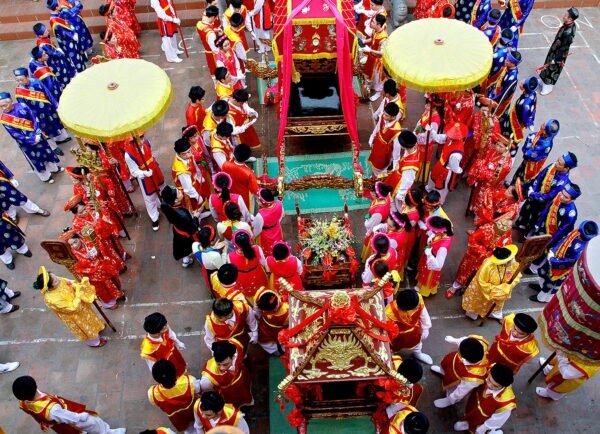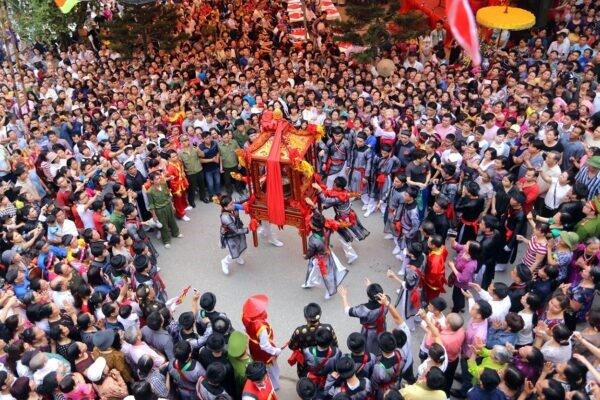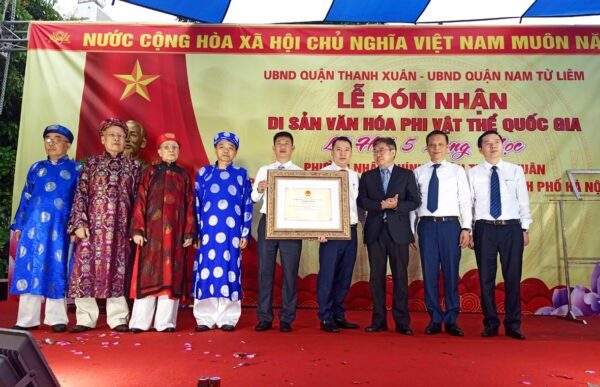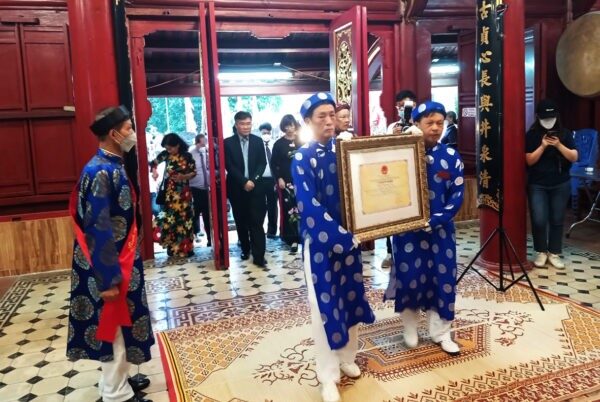Ke Moc formerly consisted of 5 villages: Giap Nhat, Quan Nhan, Chinh Kinh, Cu Loc and Phung Khoang, now belongs to Nhan Chinh Ward – Thanh Xuan District and Trung Van Ward – Nam Tu Liem District. Ke Moc was originally located on the banks of the To Lich River, in the southwest of Hanoi.
The Five Moc Village Festival is a big festival of the ancient Doai region, showing the marriage custom between the Moc villages, which is held, practiced, and handed down by the people of the 5 villages to this day. The festival lasts a whole month, now it is only wrapped up in 6 days, at Quan Nhan Communal house, mainly by Nhan Chinh ward.


The Five Moc Village Festival
The Five Villages Festival is held every year. The main celebration is held once every 5 years to process the saints to travel to spring and enjoy the scenery of the five villages and pray for the peace of the nation and the people. The venue for the festival of the year of the Moc village is held in the communal house of the Moc village. These are the communal houses of Phung Khoang, Quan Nhan, Cu Chinh, and Giap Nhat. Quan Nhan communal house is associated with the legend of Hung Lang, the Chau Ai ethic minority (Thanh Hoa). He married Truong My Nuong, a Quan Nhan person. The feudal dynasties had repeatedly conferred the title of Hung Lang as “Trung Nghia Dai Vuong” and his wife was ordained as “Duc Duc De My Quan Nhan Vuong Cong Chua“.
Many rituals are performed throughout the five Moc Village Festival, including the opening ceremony of the communal house, water procession and carpentry ceremony, Buddha bathing ceremony (wearing Saint clothing), sacrifice, and palanquin procession. Saints’ Procession on the 11th day of the second lunar month. On February 12 and 13, a parade of five villages, comprising a ritual staff, Ban drum, dragon, lion, Kieu Thanh, Long Dinh palanquin, flower palanquin, sacrifice squad… The procession sequence has been planned. Strictly, at the front are five five-element flags, followed by the flag dance team, dragon dance team, drums and gongs, lion team, pink horse, white horse, elephant, dance team, incense court, long communal house, chess team, Lo Bo team, Bat Am ward, holy palanquin, bowl tribute palanquin, flower palanquin… 5 villages in sequence over a kilometer long, the procession rests for a step every step of the route, passing by any village, the village greets and joins the parade. From a distance, the procession looks like a giant dragon with many vibrant colors. The observer cannot clearly see where the dragon’s head is, where the dragon’s tail is, but only flags, fig fans, golden leaves, incense sticks, dragon temples, elephants, wooden horses, and drums. This is the dragon dance team, the lion dance team, the earth man, etc.
The dragon dance was a staple of the Five Moc Village Festival. The dragon dance was required to offer appreciation to the Ke Moc person who created this animal to assist the Tay Son army in defeating the Qing army. There were also many folk games such as human chess, hanging bridge, catching ducks under the pond, breaking the pot, hitting the plate, blindfolded catching goats, cock fighting, swinging, traditional poker, and wrestling. There were frequently fireworks and Cheo singing in the evening. The festival is now simple; in addition to the dragon dance, there are a variety of games, cultural programs, Cheo singing, sports, and so on. However, in recent years, due to the COVID-19 epidemic situation, the Five Moc Village Festival held very compact, simple, only sacrifices, does not organize the festival games, strictly implement 5K. The sacrifices in the five Moc Village Festival in the past required pork or beef (whole body). Now the offerings to the Saints are much simpler.
With typical cultural values, the Five Ke Moc Village Festival has been recognized as a National Intangible Cultural Heritage. On April 16, 2022, the People’s Committee of Thanh Xuan District coordinated with the People’s Committee of Nam Tu Liem District to organize the National Intangible Cultural Heritage Recognition Ceremony “The Five Ke Moc Festival” at the communal house of Moc Quan Nhan village, Nhan Chinh Ward, Thanh Xuan District and Trung Van Ward, Nam Tu Liem District. The Representative leaders of Department of Cultural Heritage – Ministry of Culture, Sports and Tourism, Vietnam Heritage Association; Heritage Management Office – Hanoi Department of Culture and Sports; District Party Committee, People’s Committees of Thanh Xuan District, Nam Tu Liem District, Nhan Chinh Ward, Trung Van Ward and a large number of people from the two districts attended.

The Representatives of Thanh Xuan and Nam Tu Liem districts received the National Intangible Cultural Heritage Recognition Certificate “Festival of 5 Ke Moc Villages”

Receiving the National Intangible Cultural Heritage Certificate to the Communal house
Speaking at the ceremony to receive National Intangible Cultural Heritage Certificate, Mr. Dang Khanh Hoa – District Commissioner, Vice Chairman of People’s Committee of Thanh Xuan District affirmed: the Festival of 5 Moc Villages was included in the list of Intangible Cultural Heritage according to the Decision No.1727/QD-TTg dated May 27, 2021 of the Ministry of Culture, Sports and Tourism. This festival played an important role and was the pride of the Party Committees, authorities and people of Thanh Xuan District, Nam Tu Liem District as well as Nhan Chinh Ward and Trung Van Ward, which had profound influence in cultural life, contributed to facilitate the preservation, conservation and promotion of the unique cultural heritage of “Ke Moc” area. At the same time, the responsibility for the two districts, two wards and the sub-committees for the management of monuments was set to improve the efficiency of the management, protection and promotion of the relic value.
Thanh Quy
